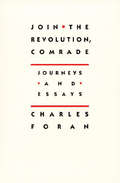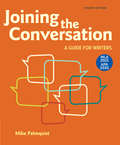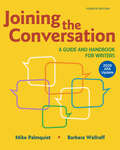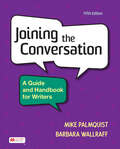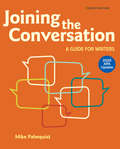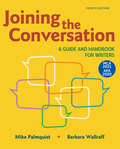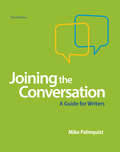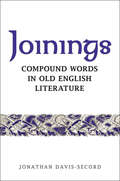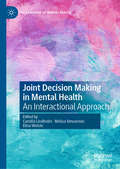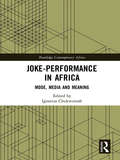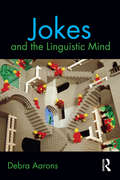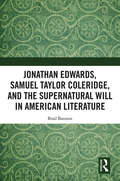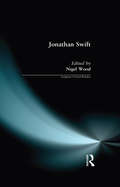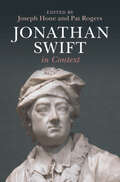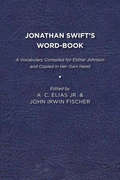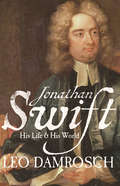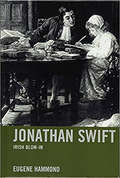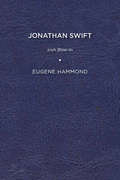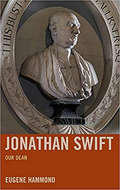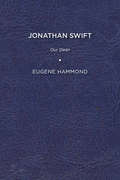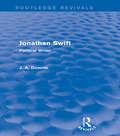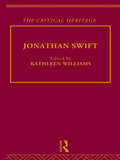- Table View
- List View
Johnson's Milton
by Christine ReesSamuel Johnson is often represented as primarily antagonistic or antipathetic to Milton. Yet his imaginative and intellectual engagement with Milton's life and writing extended across the entire span of his own varied writing career. As essayist, poet, lexicographer, critic and biographer - above all as reader - Johnson developed a controversial, fascinating and productive literary relationship with his powerful predecessor. To understand how Johnson creatively appropriates Milton's texts, how he critically challenges yet also confirms Milton's status, and how he constructs him as a biographical subject, is to deepen the modern reader's understanding of both writers in the context of historical continuity and change. Christine Rees's insightful study will be of interest not only to Milton and Johnson specialists, but to all scholars of early modern literary history and biography.
Join an Adventure Club!
by Jessica QuiltyThe fun and excitement of English and Language Arts learning continues in Grade 2 of Reading Street. This comprehensive and dynamic curriculum for homeschooling is geared toward young children who have some foundational English and Language Arts knowledge and are ready to strengthen their skills. Comprised of engaging activities, challenging content and weekly quizzes, Reading Street: Grade 2 is the next step in your child's path toward becoming a lifelong learner and reader. As with all Reading Street products, the Grade 2 system is formatted to help students meet certain age-appropriate goals. After completing this English and Language Arts homeschool program, your child should be able to: Read and comprehend two-syllable words. Identify common prefixes (such as pre-, un-, or re-) and suffixes (such as -able, -ad and -er). Correct mistakes made when reading out loud. Read books with two or more chapters. Understand the structure of stores (i. e. beginning, middle and end). Start selecting reading materials based on his/her own interests. Identify the "who," "what," "when," "where," "why" and "how" of the text. While the goals of second Grade English and Language Arts are numerous, Reading Street will help you craft engrossing lessons. Your child will garner important English and Language Arts skills while completing a workbook, reading stories and poems, and taking assessments. Planning these lessons will be easier than ever, as all Reading Street systems are broken down into weekly Big Ideas. All the work your child does on a given week is formulated around that single concept for an organized and challenging curriculum. With six easy-to-follow units, Reading Street: Grade 2 is the perfect tool for homeschooling parents. Your child will enjoy the reading selections and activities, and you'll love to see your student growing into a knowledgeable individual. We're confident that this product is the right one for you. For more information on the specific materials found in Grade 2 of Reading Street, check out the Features and Benefits page.
Join the Revolution, Comrade
by Charles ForanIn this collection of essays, Foran visits places in Vietnam that have been 'colonized' by western war films, talks to Shanghai residents about their colossal city, and commiserates with the people of Bali about the effects of terrorist bombs on their island. He also 'encounters' Miguel de Cervantes, the Buddha of Compassion, and the pumped-up American Tom Wolfe.
Joining the Conversation with 2020 APA and 2021 MLA Updates: A Guide for Writers
by Mike Palmquist Barbara WallraffThis ebook has been updated to provide you with the latest guidance on documenting sources in MLA style and follows the guidelines set forth in the MLA Handbook, 9th edition (April 2021).Grounded in the best practices of effective writing instruction, Joining the Conversation’s rhetorical approach teaches students the key critical thinking skills they will draw on as they begin to explore and respond thoughtfully to the complex conversations around them. From reflective and informative to analytical and persuasive writing, chapters follow real student writers as they find a conversation, develop, revise, and document their writing. Thoroughly revised, the fourth edition includes new student projects and more support for academic reading, critical thinking, and assessing credibility and bias.
Joining the Conversation: A Guide And Handbook For Writers
by Mike Palmquist Barbara WallraffWith 2020 APA Update. Grounded in the best practices of effective writing instruction, Joining the Conversation’s rhetorical approach teaches students the key critical thinking skills they will draw on as they begin to explore and respond thoughtfully to the complex conversations around them. From reflective and informative to analytical and persuasive writing, chapters follow real student writers as they find a conversation, develop, revise, and document their writing. Thoroughly revised, the fourth edition includes new student projects and more support for academic reading, critical thinking, and assessing credibility and bias.
Joining the Conversation: A Guide For Writers
by Mike Palmquist Barbara WallraffJoining the Conversation empowers you to make informed decisions about every aspect of the writing process.
Joining the Conversation: A Guide For Writers
by Mike PalmquistWith 2020 APA Update Grounded in the best practices of effective writing instruction, Joining the Conversation’s rhetorical approach teaches students the key critical thinking skills they will draw on as they begin to explore and respond thoughtfully to the complex conversations around them. From reflective and informative to analytical and persuasive writing, chapters follow real student writers as they find a conversation, develop, revise, and document their writing. Thoroughly revised, the fourth edition includes new student projects and more support for academic reading, critical thinking, and assessing credibility and bias.
Joining the Conversation: A Guide and Handbook for Writers with 2020 APA and 2021 MLA Updates
by Mike Palmquist Barbara WallraffThis ebook has been updated to provide you with the latest guidance on documenting sources in MLA style and follows the guidelines set forth in the MLA Handbook, 9th edition (April 2021).Grounded in the best practices of effective writing instruction, Joining the Conversation’s rhetorical approach teaches students the key critical thinking skills they will draw on as they begin to explore and respond thoughtfully to the complex conversations around them. From reflective and informative to analytical and persuasive writing, chapters follow real student writers as they find a conversation, develop, revise, and document their writing. Thoroughly revised, the fourth edition includes new student projects and more support for academic reading, critical thinking, and assessing credibility and bias.
Joining the Conversation: A Guide for Writers, 3e
by Mike PalmquistGrounded in the best practices of effective writing instruction, Joining the Conversation's rhetorical approach builds an awareness of writing purposes and genres as it teaches students to read critically, research effectively, and respond thoughtfully to the conversations around them. Comprehensive assignment chapters span reflective, informative, analytical and persuasive writing, following real students throughout their writing processes. Supportive apparatus guides writers from finding a conversation to join all the way through documenting their essays. Throughout the text, with techno-literate practice at the fore, multimodality is always an option and the conversation metaphor empowers students to make their voices heard--with their peers, in academic communities, and in the world. Based on reviewer feedback, the third edition of Joining the Conversation offers a new opening chapter on understanding yourself as a writer, more substantial academic readings on compelling subjects that matter to students, and an expanded digital option in Launchpad for Joining the Conversation. With theory put into practice, Joining the Conversation exemplifies the best of what writing instruction should be.
Joinings: Compound Words in Old English Literature
by Jonathan Davis-SecordThe first comprehensive study of the use of compound words in Old English poetry, homilies, and philosophy, Joinings explores the effect of compounds on style, pace, clarity, and genre in Anglo-Saxon vernacular literature. Jonathan Davis-Secord demonstrates how compounds affect the pacing of passages in Beowulf, creating slow-motion narrative at moments of significant violence; how their structural complexity gives rhetorical emphasis to phrases in the homilies of Wulfstan; and how they help to mix quotidian and elevated diction in Cynewulf's Juliana and the Old English translations of Boethius. His work demonstrates that compound words were the epitome of Anglo-Saxon vernacular verbal art, combining grammar, style, and culture in a manner unlike any other feature of Old English.
Joint Decision Making in Mental Health: An Interactional Approach (The Language of Mental Health)
by Camilla Lindholm Melisa Stevanovic Elina WeisteThis volume studies joint decision making in mental health care contexts through an in-depth examination of the negotiations of power and authority at the level of turn-by-turn sequential unfolding of interaction. Bringing together research at the intersection of mental health, discourse and conversation analysis it examines a wide range of settings including chronic psychiatric visits, rehabilitation meetings, occupational therapy encounters and cognitive behavioral therapy appointments. It presents a series of studies which reveal in close detail the joint decision-making processes in these critical encounters by using naturally occurring video-recorded interactions from a range of health service settings as data. In so doing, it sheds light on the interactional practices of health care workers that may facilitate or discourage client participation in joint decision-making processes. The book will provide important insights for academics and practitioners working in the fields of psychology, psychotherapy, applied linguistics, nursing, social work and rehabilitation; and in particular for those specializing in psychiatry and mental health.
Joke-Performance in Africa: Mode, Media and Meaning (Routledge Contemporary Africa)
by Ignatius ChukwumahJokes have always been part of African culture, but never have they been so blended with the strains and gains of the contemporary African world as today. Joke-Performance in Africa describes and analyses the diverse aesthetics, forms, and media of jokes and their performance and shows how African jokes embody the anxieties of the time and space in which they are enacted. The book considers the pervasive phenomenon of jokes and their performance across Africa in such forms as local jests, street jokes, cartoons, mchongoano, ewhe-eje, stand-up comedy, internet sex jokes, and ‘comicast’ transmitted via modern technology media such as the TV, CDs, DVDs, the internet platforms of YouTube, Facebook, and other social arenas, as well as live performances. Countries represented are Egypt, Kenya, Malawi, Morocco, Nigeria, and Zambia, covering the North, West, East and Southern Africa. The book explores the description of the joke form from various perspectives, ranging from critical discourse analysis, interviews, humour theories, psychoanalysis, the postcolony and technauriture, to the interactive dramaturgy of joke-performances, irrespective of media and modes of performance. Containing insightful contributions from leading African scholars, the book acquaints readers with detailed descriptions of the diverse aesthetics of contemporary African jokes, thereby contributing to the current understanding of joke-performance in Africa. It will appeal to students and scholars of African studies, popular culture, theatre, performance studies and literary studies.
Jokes and the Linguistic Mind
by Debra AaronsThrough the lens of cognitive science, Jokes and the Linguistic Mind investigates jokes that play on some aspect of the structure and function of language. In so doing, Debra Aarons shows that these 'linguistic jokes' can evoke our tacit knowledge of the language we use. Analyzing hilarious examples from movies, plays and books, Jokes and the Linguistic Mind demonstrates that tacit linguistic knowledge must become conscious for linguistic jokes to be understood. The book examines jokes that exploit pragmatic, semantic, morphological, phonological and semantic features of language, as well as jokes that use more than one language and jokes that are about language itself. Additionally, the text explores the relationship between cryptic crossword clues and linguistic jokes in order to demonstrate the difference between tacit knowledge of language and rules of language use that are articulated for a particular purpose. With its use of jokes as data and its highly accessible explanations of complex linguistic concepts, this book is an engaging supplementary text for introductory courses in linguistics, psycholinguistics and cognitive science. It will also be of interest to scholars in translation studies, applied linguistics and philosophy of language.
Jonathan Edwards, Samuel Taylor Coleridge, and the Supernatural Will in American Literature
by Brad BannonIn a work that will be of interest to students and scholars of American Literature, Romanticism, Transcendentalism, the History of Ideas,and Religious Studies, Brad Bannon examines Samuel Taylor Coleridge’s engagement with the philosophical theology of Jonathan Edwards. A closer look at Coleridge’s response to Edwards clarifies the important influence that both thinkers had on seminal works of the nineteenth century, ranging from the antebellum period to the aftermath of the American Civil War—from Poe’s fiction and Emerson’s essays to Melville’s Billy Budd and Crane’s The Red Badge of Courage. Similarly, Coleridge’s early espousal of an abolitionist theology that had evolved from Edwards and been shaped by John Woolman and Olaudah Equiano sheds light on the way that American Romantics later worked to affirm a philosophy of supernatural self-determination. Ultimately, what Coleridge offered the American Romantics was a supernatural modification of Edwards’ theological determinism, a compromise that provided Emerson and other nineteenth-century thinkers with an acceptable extension of an essentially Calvinist theology. Indeed, a thoroughgoing skepticism with respect to salvation, as well as a faith in the absolute inscrutability of Providence, led both the Transcendentalists and the Dark Romantics to speculate freely on the possibility of supernatural self-determination while doubting that anything other than God, or nature, could harness the power of causation.
Jonathan Swift (Longman Critical Readers)
by Nigel WoodThis collection of critical thinking situates the satire of Jonathan Swift within both its eighteenth-century contexts and our modern anxieties about personal identity and communication. Augustan satire at its most provocative is not simply concerned with the public matters of politics or religion, but also offers a precise medium in which to express the paradox of ironic detachment amidst deep conviction. The critics chosen for this volume demonstrate the complexity of Swift's work. Its four sections explore matters of authorial identity, the relation between Swift's writing and its historical context, the full range of his comments on gender, and his deployment of metaphor and irony to engage the reader. Swift has often been regarded as a writer who anticipated many twentieth-century cultural preoccupations, and this volume provides an opportunity to test just how modern he actually was. It also provides an answer to those who would wish to simplify his writing as that of Tory and misogynist. The theoretical perspectives of the contributors are lucidly explained and their critical terms located in the wider contexts of contemporary theory in the introduction and headnotes. The volume places Swift historically within the philosophical and religious traditions of eighteenth-century thought.
Jonathan Swift and the Eighteenth-Century Book
by Paddy Bullard James MclavertyJonathan Swift lived through a period of turbulence and innovation in the evolution of the book. His publications, perhaps more than those of any other single author, illustrate the range of developments that transformed print culture during the early Enlightenment. Swift was a prolific author and a frequent visitor at the printing house, and he wrote as critic and satirist about the nature of text. The shifting moods of irony, complicity and indignation that characterise his dealings with the book trade add a layer of complexity to the bibliographic record of his published works. The essays collected here offer the first comprehensive, integrated survey of that record. They shed new light on the politics of the eighteenth-century book trade, on Swift's innovations as a maker of books, on the habits and opinions revealed by his commentary on printed texts and on the re-shaping of the Swiftian book after his death.
Jonathan Swift in Context (Literature in Context)
by Pat Rogers Joseph HoneJonathan Swift remains the most important and influential satirist in the English language. The author of Gulliver's Travels, A Modest Proposal, and A Tale of a Tub, in addition to vast numbers of political pamphlets, satirical verses, sermons, and other kinds of text, Swift is one of the most versatile writers in the literary canon. His writings were always closely intertwined with the English and Irish worlds in which he lived. The forty-four essays collected in Jonathan Swift in Context advance the latest research on Swift in a way that will engage undergraduate students while also remaining useful for scholars. Reflecting the best of current and ongoing scholarship, the contextual approach advanced by this volume will help to make Swift's works even more powerful and resonant to modern audiences.
Jonathan Swift's Word-Book: A Vocabulary Compiled for Esther Johnson and Copied in Her Own Hand
by A. C. Elias Jr. John Irwin FischerThis Word-Book is presumably the only work of Jonathan Swift’s not in print, until now. Since the 1690s, Swift had been formulating a list of words and definitions for his protégé Esther Johnson, beginning with terms from the Book of Common Prayer. His was apparently an ongoing list, kept rather haphazardly, with open spaces for adding new words. About 1710, when Swift was in London, Johnson, in Dublin, set out to formalize the dictionary, copying out Swift’s words and definitions to make an orderly and careful book with no blank spaces. Probably in 1713, when Swift returned to Ireland, Johnson presented her Word-Book to him, but his school-masterly corrections of her work may have offended her. After Johnson’s death in 1728, Swift gave the Word-Book to their mutual friend, Elizabeth Sican. It was passed down over generations, until in 1976, the young American Swiftian A. C. Elias, Jr., bought it, intending to edit it in his old age. Before his early death in 2008, Elias asked John Fischer to assume the challenge of bringing the book into print. Fischer took on the task until 2015, when he too passed away, after which his wife Panthea Reid completed the task. This volume includes illustrations from the original book, a transcript of it with schematic indications of Swift’s corrections, as well as essays and appendices by Fischer and Elias tracing provenance, exploring the social and psychological milieu in which the book was written, and tracking Swift’s work as a lexicographer. Published by University of Delaware Press. Distributed worldwide by Rutgers University Press.
Jonathan Swift: His Life and His World
by Leo DamroschJonathan Swift is best remembered today as the author of Gulliver's Travels, the satiric fantasy that quickly became a classic and has remained in print for nearly three centuries. Yet Swift also wrote many other influential works, was a major political and religious figure in his time, and became a national hero, beloved for his fierce protest against English exploitation of his native Ireland. What is really known today about the enigmatic man behind these accomplishments? Can the facts of his life be separated from the fictions? In this deeply researched biography, Leo Damrosch draws on discoveries made over the past thirty years to tell the story of Swift's life anew. Probing holes in the existing evidence, he takes seriously some daring speculations about Swift's parentage, love life, and various personal relationships and shows how Swift's public version of his life--the one accepted until recently--was deliberately misleading. Swift concealed aspects of himself and his relationships, and other people in his life helped to keep his secrets. . Assembling suggestive clues, Damrosch re-narrates the events of Swift's life while making vivid the scents, sounds, and smells of his English and Irish surroundings. Through his own words and those of a wide circle of friends, a complex Swift emerges: a restless, combative, empathetic figure, a man of biting wit and powerful mind, and a major figure in the history of world letters.
Jonathan Swift: Irish Blow-In
by Eugene HammondJonathan Swift: Irish Blow-in covers the arc of the first half of Jonathan Swift’s life, offering fresh details of the contentment and exuberance of his childhood, of the support he received from his grandmother, of his striking affection for Esther Johnson from the time she was ten years old (his pet name for her in her twenties was “saucebox”), of his precocious entry into English politics with his Contests and Dissensions pamphlet, of his brilliant and much misunderstood Tale of a Tub, and of his naive determination to do well both as a vicar of the small parish of Laracor in Ireland and as a writer for the Tory administration trying to pull England out of debt by ending the war England was engaged in with France. I do not share with past biographers the sense that Swift had a deprived childhood. I do not share the suspicion that most of Swift’s enmities were politically motivated. I do not feel critical of him because he was often fastidious with his money. I do not think he was insincere about his religious faith. His pride, his sexual interests, his often shocking or uninhibited language, his instinct for revenge – emphasized by many previous biographers – were all fundamental elements of his being, but elements that he either used for rhetorical effect, or that he tried to keep in check, and that he felt that religion helped him to keep in check. Swift had as firm a conviction as did Freud that we are born with wayward tendencies; unlike Freud, though, he saw both religion and civil society as necessary and helpful checks on those wayward tendencies, and he (frequently, but certainly not always) acknowledged that he shared those tendencies with the rest of us. This biography, in two books, Jonathan Swift: Irish Blow-in and Jonathan Swift:Our Dean, will differ from most literary biographies in that it does not aim to show how Swift’s life illuminates his writings, but rather how and why Swift wrote in order to live the life he wanted to live. I have liberally quoted Swift’s own words in this biography because his inventive expression of ideas, both in his public works and in his private letters, was what has made him a unique and compelling figure in the history of literature. I hope in these two books to come closer than past biographies to capturing how it felt to Swift himself to live his life. Published by University of Delaware Press. Distributed worldwide by Rutgers University Press.
Jonathan Swift: Irish Blow-In
by Eugene HammondJonathan Swift: Irish Blow-in covers the arc of the first half of Jonathan Swift’s life, offering fresh details of the contentment and exuberance of his childhood, of the support he received from his grandmother, of his striking affection for Esther Johnson from the time she was ten years old (his pet name for her in her twenties was “saucebox”), of his precocious entry into English politics with his Contests and Dissensions pamphlet, of his brilliant and much misunderstood Tale of a Tub, and of his naive determination to do well both as a vicar of the small parish of Laracor in Ireland and as a writer for the Tory administration trying to pull England out of debt by ending the war England was engaged in with France. I do not share with past biographers the sense that Swift had a deprived childhood. I do not share the suspicion that most of Swift’s enmities were politically motivated. I do not feel critical of him because he was often fastidious with his money. I do not think he was insincere about his religious faith. His pride, his sexual interests, his often shocking or uninhibited language, his instinct for revenge – emphasized by many previous biographers – were all fundamental elements of his being, but elements that he either used for rhetorical effect, or that he tried to keep in check, and that he felt that religion helped him to keep in check. Swift had as firm a conviction as did Freud that we are born with wayward tendencies; unlike Freud, though, he saw both religion and civil society as necessary and helpful checks on those wayward tendencies, and he (frequently, but certainly not always) acknowledged that he shared those tendencies with the rest of us. This biography, in two books, Jonathan Swift: Irish Blow-in and Jonathan Swift: Our Dean, will differ from most literary biographies in that it does not aim to show how Swift’s life illuminates his writings, but rather how and why Swift wrote in order to live the life he wanted to live. I have liberally quoted Swift’s own words in this biography because his inventive expression of ideas, both in his public works and in his private letters, was what has made him a unique and compelling figure in the history of literature. I hope in these two books to come closer than past biographies to capturing how it felt to Swift himself to live his life. Published by University of Delaware Press. Distributed worldwide by Rutgers University Press.
Jonathan Swift: Our Dean
by Eugene HammondJonathan Swift: Our Dean details the political climax of his remarkable career—his writing and publication of The Drapier’s Letters (1724), Gulliver’s Travels (1726), and A Modest Proposal (1729)—stressing the relentless political opposition he faced and the numerous ways, including through his sermons, that he worked from his political base as Dean of St. Patrick’s Cathedral, psychologically as well as physically just outside the Dublin city walls, to attempt to rouse the Irish people to awareness of the ways that England was abusing them. This book faces squarely the likelihood that Swift had a physical affair with Esther Vanhomrigh between 1719 and 1723, and reassesses in the light of that likelihood his conflicting relations with Esther Vanhomrigh and Esther Johnson. It traces the many loving friendships with both men and women in Ireland that sustained Swift during the years when his health gradually failed him, enabling him to continue indefatiguably, both through his writings and his authority as Dean of St. Patrick’s, to contribute to the public welfare in the face of relentless British attempts to squeeze greater and greater profits out of their Irish colony. Finally, it traces how Swift’s political indignation led to his treating many people, friends and enemies, cruelly during the 1730s, even while his humor and his ability to make and attract new friends sustained themselves until his memory finally failed him in 1742. This biography, in two books, Jonathan Swift: Irish Blow-in and Jonathan Swift:Our Dean, comes closer than past biographies to capturing how it felt to Swift himself to live his life. Published by University of Delaware Press. Distributed worldwide by Rutgers University Press.
Jonathan Swift: Our Dean
by Eugene HammondJonathan Swift: Our Dean details the political climax of his remarkable career—his writing and publication of The Drapier’s Letters (1724), Gulliver’s Travels (1726), and A Modest Proposal (1729)—stressing the relentless political opposition he faced and the numerous ways, including through his sermons, that he worked from his political base as Dean of St. Patrick’s Cathedral, psychologically as well as physically just outside the Dublin city walls, to attempt to rouse the Irish people to awareness of the ways that England was abusing them. This book faces squarely the likelihood that Swift had a physical affair with Esther Vanhomrigh between 1719 and 1723, and reassesses in the light of that likelihood his conflicting relations with Esther Vanhomrigh and Esther Johnson. It traces the many loving friendships with both men and women in Ireland that sustained Swift during the years when his health gradually failed him, enabling him to continue indefatiguably, both through his writings and his authority as Dean of St. Patrick’s, to contribute to the public welfare in the face of relentless British attempts to squeeze greater and greater profits out of their Irish colony. Finally, it traces how Swift’s political indignation led to his treating many people, friends and enemies, cruelly during the 1730s, even while his humor and his ability to make and attract new friends sustained themselves until his memory finally failed him in 1742. This biography, in two books, Jonathan Swift: Irish Blow-in and Jonathan Swift:Our Dean, comes closer than past biographies to capturing how it felt to Swift himself to live his life. Published by University of Delaware Press. Distributed worldwide by Rutgers University Press.
Jonathan Swift: Political Writer (Routledge Revivals)
by Alan DownieFirst published in 1984, this biography gives an account of Jonathan Swift’s political ideas and provides a critical commentary on his major works. With its emphasis on Swift as a political writer, the title offers a revision of the prevailing view of Swift’s politics and its application in the study of his works. Alan Downie argues that in terms of the party politics of the day Swift is neither a Whig nor Tory. Swift thought of himself as an ‘Old Whig’, and said he was ‘of the old Whig principles, without the modern articles and refinements’. Downie shows how Swift’s writings consistently make political points about society’s deviation from an ideal. As Swift’s views on morality, religion and politics are so closely linked, an understanding of his political ideas is vital; this reissue provides a detailed analysis of this aspect of Swift’s writings and views, and as such will be of great interest to any students researching his satire.
Jonathan Swift: The Critical Heritage (Critical Heritage Ser.)
by Kathleen WilliamsThe Critical Heritage gathers together a large body of critical sources on major figures in literature. Each volume presents contemporary responses to a writer's work, enabling student and researcher to read the material themselves.

